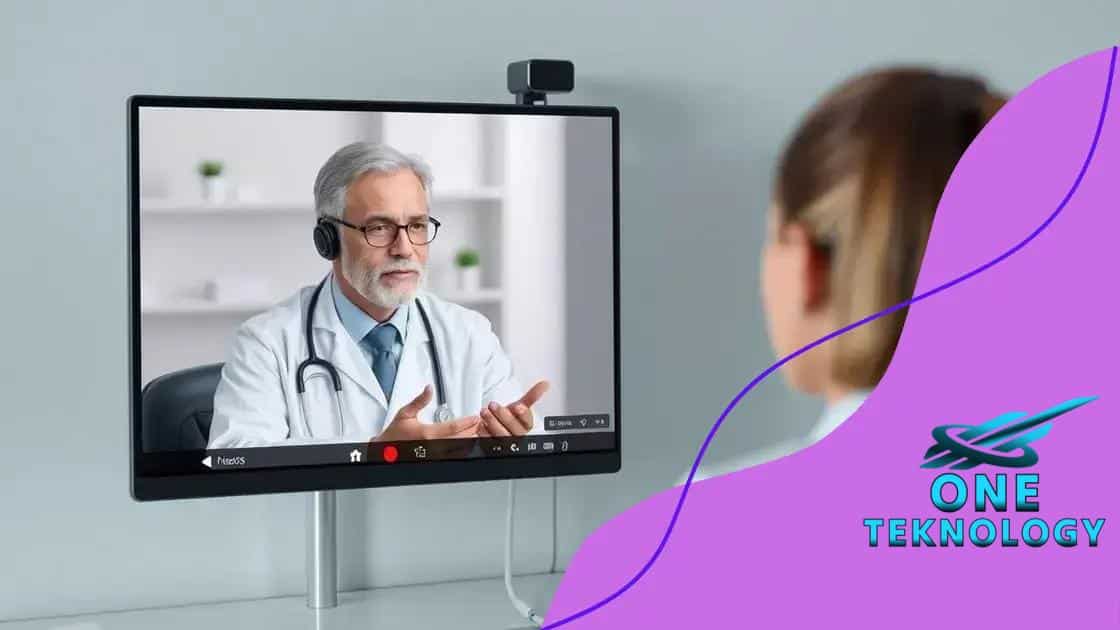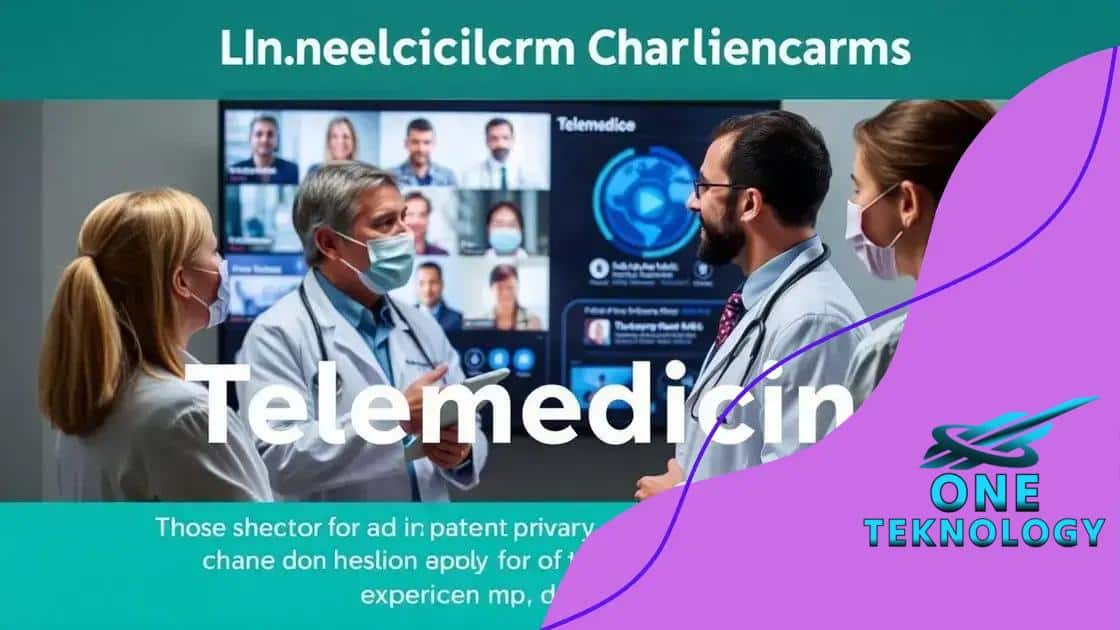How telemedicine is reshaping healthcare benefits

Telemedicine is reshaping healthcare benefits by enhancing accessibility, reducing costs, and improving patient engagement through innovative technology, such as AI and wearable devices.
How telemedicine is reshaping healthcare benefits is not just a buzzword but a real change in how we access medical care. Have you ever wondered how this affects your own healthcare experience? Let’s dive in.
Understanding telemedicine and its significance
Telemedicine is a revolutionary way of delivering healthcare. It utilizes technology to connect patients and healthcare providers, making access easier and more efficient. Understanding telemedicine is crucial as it directly impacts patient care and outcomes.
This method breaks barriers, allowing patients to receive care from the comfort of their homes. With telemedicine, geographical limitations are minimized, ensuring that everyone can access medical attention when needed.
Benefits of telemedicine
By embracing telemedicine, patients can enjoy several advantages:
- Convenience: Consultations can occur from anywhere, saving time and travel expenses.
- Access to specialists: Patients can connect with experts who may not be available locally.
- Improved monitoring: Ongoing care is easier with telehealth check-ins.
Healthcare providers also benefit significantly from this approach. They can optimize their schedules and reach more patients than in traditional settings. Moreover, the use of telemedicine can lead to enhanced patient engagement.
Impact on patient experience
Patients often report higher satisfaction levels when using telemedicine. The ability to receive care without the stress of travel is a game changer. Additionally, follow-up visits can be conducted more easily, ensuring that patients remain connected to their healthcare teams.
Telemedicine also emphasizes preventive care. With easy access to healthcare resources, patients are more likely to seek care before health issues escalate. This proactive approach leads to better health outcomes and reduces hospital visits.
As we understand the significance of telemedicine, it becomes evident that this innovation in healthcare is not just a trend but a necessity for the future of effective patient care.
Key benefits of telemedicine for patients
Telemedicine offers a myriad of benefits to patients, transforming the way healthcare is delivered. By utilizing modern technology, patients can enjoy enhanced access to medical services, making healthcare more accessible than ever before.
One major benefit is the convenience of receiving care from home. Patients can avoid long waits in crowded waiting rooms and schedule appointments that fit their busy lives. This no-travel approach reduces stress and saves precious time.
Financial Savings
Another significant advantage is the potential for cost savings. With fewer transportation expenses and often lower consultation fees, telemedicine can be a more affordable option for many patients.
- Elimination of travel costs
- Lower copays for virtual visits
- Fewer missed workdays
Moreover, telemedicine facilitates better communication between doctors and patients. Through video consultations, healthcare providers can visually assess conditions, leading to more accurate diagnoses.
Improved Access to Specialists
Patients, especially those in rural areas, can access a wider range of specialists via telemedicine. Waiting for specialist appointments can take weeks or even months. However, with telemedicine, scheduling is often quicker, allowing patients to receive timely care when it matters most.
This is particularly important for patients managing chronic conditions who need regular follow-ups. Regular virtual check-ins not only keep healthcare providers informed but also encourage patients to stay engaged in their treatment plans. This continuous connection fosters a supportive environment that promotes better health outcomes.
Finally, telemedicine enhances privacy for patients. Discussing sensitive health issues from the comfort of one’s home can reduce anxiety and make patients feel more at ease during consultations. Overall, the key benefits of telemedicine for patients highlight its role in making healthcare more efficient, affordable, and accessible.
Challenges faced in telemedicine implementation

While telemedicine presents numerous advantages, it also comes with its share of challenges. Understanding these obstacles is crucial for effective implementation and maximizing its potential benefits.
One major issue is the technological gap. Not all patients have access to reliable internet connections or the necessary devices to participate in telehealth. This can create inequities in healthcare access, especially for elderly patients or those in rural areas.
Regulatory Barriers
Another significant challenge involves navigating laws and regulations. Different states may have varying rules regarding telemedicine practices, which can complicate matters for healthcare providers. Many practitioners may find it difficult to stay compliant while extending their services across state lines.
- Varied licensing requirements
- Insurance reimbursement policies
- Limited telehealth coverage in some areas
Additionally, patient privacy concerns pose a critical challenge in telemedicine. Many individuals are worried about sharing sensitive health information digitally. Cybersecurity threats can also jeopardize the safety of patient data, making it essential for providers to have robust protections in place.
Technology Adoption
Healthcare professionals must adapt to new technologies, which can take time and training. Some providers may be hesitant to embrace telemedicine due to unfamiliarity or discomfort with digital tools. This can slow the adoption process and limit the reach of telehealth services.
Furthermore, the lack of face-to-face interaction can impact the doctor-patient relationship. Many patients still prefer personal consultations for building trust and rapport. Telemedicine may not fully replicate the comfort of an in-person visit, which can deter some individuals from utilizing these services.
Addressing these challenges is crucial for the growth of telemedicine. By focusing on improving access, understanding regulations, ensuring privacy, and promoting technology use, healthcare systems can better harness the benefits of this innovative approach.
The role of technology in enhancing telemedicine
Technology plays a vital role in enhancing telemedicine, creating a bridge between patients and healthcare providers. This advancement allows for more efficient and accessible medical care.
One of the key aspects of telemedicine is the use of digital communication tools. These tools enable patients to connect with their doctors via video calls, instant messaging, or secure portals. This immediate access to healthcare advice is especially important in urgent situations.
Innovative Applications
Various applications and devices contribute to the success of telemedicine. For instance, wearable health monitors track vital signs, allowing healthcare providers to receive real-time data. This technology helps in managing chronic diseases effectively.
- Heart rate monitors for cardiovascular health
- Glucose monitors for diabetes management
- Fitness trackers for overall wellness
Moreover, artificial intelligence (AI) enhances telemedicine by analyzing patient data to provide personalized recommendations. AI can help with early diagnosis by identifying patterns in health records, leading to timely interventions.
Improving Patient Engagement
Telemedicine technology not only facilitates communication but also actively engages patients in their healthcare journeys. Through online portals, patients can access their medical history, schedule appointments, and refill prescriptions. This level of engagement empowers patients and encourages them to take an active role in their health.
Furthermore, remote consultations improve patient compliance. When patients can easily connect with their healthcare providers, they are more likely to follow treatment plans and attend follow-up appointments.
Data security has also become crucial in the era of telemedicine. Advanced encryption methods protect patient information, ensuring privacy and compliance with regulations. With robust security measures, patients can feel confident sharing their health data online.
In summary, technology is at the forefront of enhancing telemedicine, making healthcare more accessible, efficient, and patient-centered. By utilizing innovative tools and applications, both patients and providers can benefit from improved communication and outcomes.
Future trends in telemedicine and healthcare
The future of telemedicine and healthcare is bright, with numerous trends set to transform how we receive medical care. As technology continues to evolve, patients and providers can expect more innovative solutions that enhance healthcare delivery.
One significant trend is the increased use of artificial intelligence (AI) in telemedicine. AI can analyze patient data and provide predictive insights, enabling healthcare providers to tailor treatments more effectively. This personalized approach can lead to improved patient outcomes and greater satisfaction.
Integration of Wearable Technology
Wearable devices are becoming more common in telemedicine. These gadgets, such as smartwatches and fitness trackers, monitor health metrics in real-time and send data directly to healthcare providers. This constant stream of information helps doctors make informed decisions and address potential issues before they become serious.
- Heart rate and rhythm monitoring
- Activity tracking for lifestyle adjustments
- Real-time glucose monitoring for diabetic patients
Further developments in telemedicine include enhanced video consultation features. Providers are increasingly utilizing high-definition video and interactive tools that make virtual visits more user-friendly. Enhanced visuals allow for a better examination experience, improving communication between patients and doctors.
Emphasis on Patient-Centric Care
Another trend is the shift towards more patient-centric care. Telemedicine encourages patients to take a more active role in their health. Through online portals and apps, patients can access their medical records, understand their treatment plans, and communicate easily with their healthcare team.
Additionally, there will likely be a rise in teletherapy and mental health services. The demand for mental health support has surged, and telemedicine provides essential access to therapists and counselors. This accessibility will likely continue as society recognizes the importance of mental health.
As telemedicine continues to grow, regulations will also adapt. Governments may implement updated policies that support telehealth practices and ensure patient safety. This regulatory evolution will help maintain high standards of care while expanding services.
In summary, the future of telemedicine holds exciting possibilities. With advancements in AI, wearable technology, patient-centric care, and regulatory support, healthcare will become more efficient, accessible, and personalized for everyone.
FAQ – Frequently Asked Questions About Telemedicine
What is telemedicine?
Telemedicine is the use of technology to provide healthcare services remotely, allowing patients to connect with healthcare providers through video calls, apps, and other digital tools.
How does telemedicine improve patient access to healthcare?
Telemedicine removes geographical barriers, making it easier for patients, especially in rural areas, to access specialized medical care without needing to travel long distances.
What technologies are essential for effective telemedicine?
Essential technologies include video conferencing tools, secure messaging platforms, electronic health records (EHR), and wearable devices that monitor patient health data.
What are the security measures needed for telemedicine?
Security measures include using encrypted communication channels, ensuring compliance with regulations like HIPAA, and implementing strong data protection practices to safeguard patient information.






